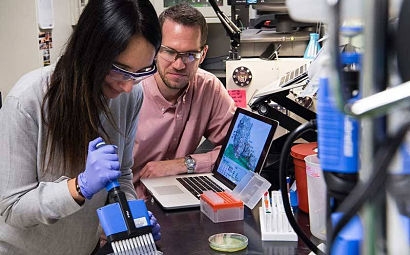
The scientists have gained new insights into how glycosylation - the natural attachment of sugars to proteins - affects a key cellulase enzyme. This work could be used to improve enzyme performance to better break down biomass and convert waste plant matter to renewable fuels and products. Namely, the more effective the enzyme, the more efficient and economical the process will be.
The new research, which focuses on the enzyme Cel7A that breaks down cellulose in plants to sugars, is detailed in the Proceedings of the National Academy of Sciences (PNAS) in a manuscript titled “Distinct roles of N- and O-glycans in cellulase activity and stability.” This study sheds light on the specific functions of small sugars, or glycans, that microbes attach to their enzymes. This enzymatic modification by the addition of sugars is referred to as ‘glycosylation’ and it is known to have a substantial impact on enzyme function.
“Enzymes for breaking down cellulose are notoriously difficult to engineer for improved activity” said NREL Staff Engineer Brandon Knott, a co-author of the paper. “It has long been realised that glycosylation is a ‘knob to turn’ in this endeavour, but the specific roles of the different glycans have been elusive.”
Attempting to resolve some of the uncertainty around how the different kinds of glycans relate to different enzyme functions, the NREL developed a unique recombinant expression system to test new enzymes, producing a large collection of Cel7A mutants that lacked various combinations of glycosylation sites. A team of researchers from NREL, the University of Georgia, and the University of Colorado, Boulder, then characterised all the mutant enzymes and compared the features to those of the native enzyme to gather critical data about the relationships between the specific glycan, its function, and its location.
“Based on the literature, we already thought that we knew the location of all of the glycosylation sites” said co-author Antonella Amore, a postdoctoral researcher at NREL. “In confirming their locations, we not only discovered new glycans, we also elucidated the structures of the glycans at each specific site. This provides insight into how the microbe is protecting and decorating its enzymes for optimal activity, which in turn provides clues on how to improve them for industrial applications.”
Gaining a deeper understanding of the basic structure, function, and relationships of proteins is fundamental to helping design new strategies to improve overall enzyme performance. But building a superior enzyme requires an understanding of a vast combination of factors. It is important to know which glycans protect against protease attacks, which ones are essential for binding to enzyme stability, and which are key for enzyme binding and activity.
NREL’s findings have revealed that, depending on its type and where it is attached, glycosylation is important for strengthening the binding of Cel7A to cellulose, protecting the enzyme against proteases that break down the protein, and bolstering the enzyme’s thermal stability, which allows the enzyme to keep working at temperatures that would be encountered in an industrial biomass conversion process.
The work reported in PNAS was funded by the DOE’s Bioenergy Technologies Office.
Image: Postdoctoral Researcher Antonella Amore and Senior Engineer Brandon Knott work on samples in the lab (Photo: Dennis Schroeder/NREL)
For additional information:

